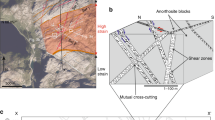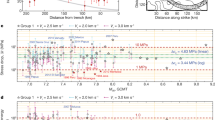Abstract
Conventional double-couple solutions do not satisfactorily account for many small magnitude earthquakes in the Hengill geothermal area in the Neovolcanic Zone of Iceland. The far-field radiation pattern is predominantly compressional but a few dilatational arrivals have been recorded. We prefer the interpretation that these events are due to tensile crack formation at a shallow (1–7 km) depth within a cooling intrusive body. Volume considerations indicate that initial fracturing of the rock is seismic but that subsequent widening proceeds aseismically. Other reports of anomalous radiation patterns from earthquakes on the Mid-Atlantic Ridge describe events of a similar type, that is, exhibiting predominantly compressional radiation patterns and a reduced dilatational field1–4.
This is a preview of subscription content, access via your institution
Access options
Subscribe to this journal
Receive 51 print issues and online access
$199.00 per year
only $3.90 per issue
Buy this article
- Purchase on Springer Link
- Instant access to full article PDF
Prices may be subject to local taxes which are calculated during checkout
Similar content being viewed by others
References
Sykes, L. R. J. geophys. Res. 72, 2131–2153 (1967).
Sykes, L. R. Bull. Seismol. Soc. Am. 60, 1749–1752 (1970).
Klein, F. W., Einarsson, P. & Wyss, M. J. geophys. Res. 82, 865–888 (1977).
Einarsson, P. Tectonophysics 55, 127–153 (1979).
Foulger, G. & Einarsson, P. J. Geophys. 47, 171–175 (1980).
Palmason, G., Crustal Structure of Iceland from Explosion Seismology (Societas Scientiarum Islandica Publ. 40, 1971).
RRISP Working Group. J. Geophys. 47, 228–238 (1980).
Julian, B. R. Nature 303, 323–325 (1983).
Bjornsson, A., Tomasson, J. & Saemundsson, K., Hengilssvaedid, stada jardhitarannsokna vorid 1974 Orkustofnun Rep. OSJHD 7415 (1974).
Haimson, B. C. & Voight, B. Pageophysics 115, 153–190 (1977).
Aki, Keiiti & Richards, P. G. Quantitative Seismology (Freeman, San Francisco, 1980).
Robson, G. R., Barr, K. G. & Luna, L. C. Nature 218, 28–32 (1968).
Bodvarsson, G. J. Engnr Ass. Iceland 36, 1–8 (1951).
Wyss, M. & Brune, J. N. J. geophys. Res. 73, 4681–4694 (1968).
Spottiswoode, S. M. & McGarr, A. Bull seismol. Soc. Am. 65, 93–112 (1975).
Solomon, S. C. & Julian, B. R. Geophys J.R. astr. Soc. 38, 265–285 (1974).
Trehu, A. M., Nabelek, J. L. & Solomon, S. C. J. geophys. Res. 86, 1701–1724 (1981).
Author information
Authors and Affiliations
Rights and permissions
About this article
Cite this article
Foulger, G., Long, R. Anomalous focal mechanisms: tensile crack formation on an accreting plate boundary. Nature 310, 43–45 (1984). https://doi.org/10.1038/310043a0
Received:
Accepted:
Issue Date:
DOI: https://doi.org/10.1038/310043a0
This article is cited by
-
Crustal permeability generated through microearthquakes is constrained by seismic moment
Nature Communications (2024)
-
Geometric Aspects of the Full Moment Tensors in the Gulf of California and the Mexican East Pacific Rise
Pure and Applied Geophysics (2016)
-
Full Moment Tensor Variations and Isotropic Characteristics of Earthquakes in the Gulf of California Transform Fault System
Pure and Applied Geophysics (2014)
-
Implosive earthquakes at the active accretionary plate boundary in northern Iceland
Nature (1989)
Comments
By submitting a comment you agree to abide by our Terms and Community Guidelines. If you find something abusive or that does not comply with our terms or guidelines please flag it as inappropriate.



